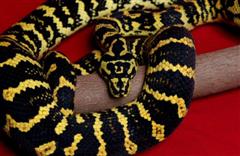Python - Jungle Carpet
Black and Gold Carpet Python, Atherton Tableland Carpet Python, Atherton Plateau Carpet Python, Rainforest Carpet Python Scientific Name: Morelia spilota cheynei
Sat, 19th April, 2025 - 5:53 am GMT
Sponsor Ads:

Alternative Name
Black and Gold Carpet Python, Atherton Tableland Carpet Python, Atherton Plateau Carpet Python, Rainforest Carpet Python Scientific Name: Morelia spilota cheyneiBasic Info
At maturity, Jungle Carpet Pythons grow to lengths between five and a half and eight and a half feet (three meters average). Females are usually larger than males. The bodies of Jungle Carpet Pythons are slender, and their triangular heads are well defined. Their tails are prehensile and strong. Usually, the lips are pitted and the scales of the head are quite small. Jungle Carpet Pythons usually have a dark pattern on their heads, often a well-defined skull and crossbones shape. Often there are dark bars over the lips and behind the eyes. The eyes are commonly dark and have dark lines below them. Usually the most striking coloration of the body is seen in young adult Jungle Carpet Pythons. These animals have bright yellow or gold markings on a black background. These rings are usually dark and pale, with paler rings sometimes forming blotches over the back and sides. The blotches over a Jungle Carpet Python's sides tend to be elongated. Younger animals tend to have more monochromatic colorings, usually gray patterns on a black background. Older animals often acquire a black hint in their yellow areas, and some older individuals become sooty in coloration. A pale stripe runs down the backs of some Jungle Carpet Pythons. Some have zigzag stripes, though in some the line is straight. Usually Jungle Carpet Pythons with this stripe show some imperfection or break in the line. Sometimes it is simply made up of connected dorsal blotches. Juvenile Carpet Pythons don't have the yellow color common to adults, instead they have more of a light tan color until they reach adulthood.
Health
Adult Jungle Carpet Python enclosures should usually have at least five to six square feet of ground area and should have adequate height to allow for climbing. Jungle Carpet Pythons should be kept between 80 and 85 degrees Fahrenheit and have a daytime basking spot about 90 - 95 degrees. The nighttime temperature should be between 75 and 80 degrees Fahrenheit. Moderate humidity should be maintained, and a water bowl should always be available. Adults should be allowed a water bowl large enough for them to soak in. Jungle Carpet Pythons tend to spend a good deal of time off their cage floors when they are allowed perches. Ideally, they would be given a hiding area on the cage floor in addition to branches or perches. It has been observed that some Jungle Carpet Pythons do not like rats, but most will accept mice or small rabbits readily. Breeding Often, in breeding Jungle Carpet Pythons, breeders attempt to create animals with purer yellow or gold markings and less sootiness in the pattern. They have been bred quite frequently in captivity. Hatchling Jungle Carpet Pythons can often be started on pinkie mice, though many do better with larger prey items like hopper mice. Many may bite, although with regular handling this seems to cease. It is recommended that they be picked up with a snake hook and then placed into the hand to help avoid being bitten.Habitat
N/ABehavior
The Jungle Carpet Python is an incredibly beautiful animal that can make a striking pet for those able to handle fairly large snakes. These lovely pythons are more docile than many species, and they are usually quite active. Jungle Carpet Pythons appear to prefer feeding from above, and will often attack prey items on the ground from a branch or perch. Adult Jungle Carpet Pythons that have been captive bred and raised and are accustomed to human handling are often described as being calm and docile animals. Native to Australia, most Jungle Carpet Pythons come from the Queensland's Atherton Tableland. Many quality captive bred specimens are available, and often their coloration can be less sooty and more pure than many wild caught snakes. However, because some Jungle Carpet Pythons have been crossbred with other species, you should be sure that your animal is pure-bred if you desire a true Jungle Carpet Python.Origin
Australia and New GuineaHistory
In the wild, Jungle Carpet Pythons inhabit moist forests and tropical rain forest areas.Common Foods
They prey primarily upon small mammals and birds.Sponsor Ads:
"My mother said to me, if you become a soldier, you'll be a general, if you become a monk, you'll end up as the pope. Instead I became a painter and wound up as Picasso." -- Pablo Picasso
Python - Jungle Carpet
Coded by: BGID® | ALL RIGHTS RESERVED Copyright © 2000-2025
Disclaimer | Privacy | Report Errors / Contact | Credits
















